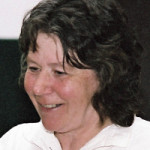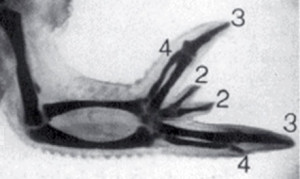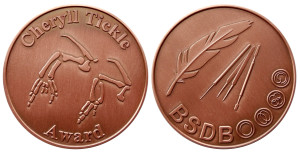
Quick access: Medallists | Nominations | Movies | Other Awards
Background & History
The Cheryll Tickle Medal is awarded annually to a mid-career, female scientist for their outstanding achievements in the field of Developmental Biology. The first medal was awarded in 2016. The recipient presents the Cheryll Tickle Award Lecture at the annual BSDB spring meeting. BSDB members are invited to nominate suitable candidates.
 The award is named after Cheryll Tickle (CBE FRS FRSE Hon FSB), an extremely eminent cell and developmental biologist who used the developing limb bud to explore pattern formation in embryogenesis. After her undergraduate studies at
The award is named after Cheryll Tickle (CBE FRS FRSE Hon FSB), an extremely eminent cell and developmental biologist who used the developing limb bud to explore pattern formation in embryogenesis. After her undergraduate studies at  Cambridge and PhD work at Glasgow, she worked as a postdoctoral researcher at Yale University, then as a postdoc in the group of Lewis Wolpert at Middlesex Hospital (later merged into UCL) where she studied the morphogen model of digit patterning. This laid the foundation for her subsequent work on the elusive limb polarising factor, mechanisms of limb outgrowth, FGF signalling, HOX gene regulation and snake limblessness. While at Middlesex/UCL, she moved up the ranks from lecturer, to reader and eventually to Professor, and shortly after she was elected a Fellow of the Royal Society, an acolade which was awarded the
Cambridge and PhD work at Glasgow, she worked as a postdoctoral researcher at Yale University, then as a postdoc in the group of Lewis Wolpert at Middlesex Hospital (later merged into UCL) where she studied the morphogen model of digit patterning. This laid the foundation for her subsequent work on the elusive limb polarising factor, mechanisms of limb outgrowth, FGF signalling, HOX gene regulation and snake limblessness. While at Middlesex/UCL, she moved up the ranks from lecturer, to reader and eventually to Professor, and shortly after she was elected a Fellow of the Royal Society, an acolade which was awarded the  same year she moved to Dundee (1998). Cheryll was the first ever Waddington medal winner (1998) and became the first female Royal Society Foulerton Fellow (2000). Currently Professor Emeritus at the University of Bath, she continues to explore diverse limb projects such as the loss of the pelvic fin in natural populations of sticklebacks as well as ectopic bone formation in wounded war veterans. Please, read the interview with Cheryll on The Node.
same year she moved to Dundee (1998). Cheryll was the first ever Waddington medal winner (1998) and became the first female Royal Society Foulerton Fellow (2000). Currently Professor Emeritus at the University of Bath, she continues to explore diverse limb projects such as the loss of the pelvic fin in natural populations of sticklebacks as well as ectopic bone formation in wounded war veterans. Please, read the interview with Cheryll on The Node.
 The Cheryll Tickle medal was designed by Andreas Prokop and Megan Davey in discussion with Cheryll Tickle. It depicts the famous digit aberrations that occur upon transplantation / manipulation of the zone of polarizing activity (ZPA) or implantation of beads soaked in retinoic acid or sonic hedgehog (for details see Towers & Tickle, 2009, Int J Dev Biol 53, 805ff). Cheryll performed much of this work in chick as illustrated by the feather on the medal’s flip side, which also shows the typical tool set required for experimental operations and the BSDB logo depicting in ovo development from egg to embryo.
The Cheryll Tickle medal was designed by Andreas Prokop and Megan Davey in discussion with Cheryll Tickle. It depicts the famous digit aberrations that occur upon transplantation / manipulation of the zone of polarizing activity (ZPA) or implantation of beads soaked in retinoic acid or sonic hedgehog (for details see Towers & Tickle, 2009, Int J Dev Biol 53, 805ff). Cheryll performed much of this work in chick as illustrated by the feather on the medal’s flip side, which also shows the typical tool set required for experimental operations and the BSDB logo depicting in ovo development from egg to embryo.
Cheryll Tickle Medallists
All recipients
- 2022 Emma Rawlins – [talk]– [Q and A the Node]
- 2020 Tatjana Sauka-Spengler – [blog post] – [Q and A with the node]
- 2019 Bénédicte Sanson – [blog post] – [Q and A with the node] – [interview]
- 2018 Christiana Ruhrberg – [letter #37/38] – [video] – [blog post] – [interview]
- 2017 Jenny Nichols – [letter #37/38] – [video] – [blog post] – [interview]
- 2016 Abigail Saffron Tucker – [letter #36] [lecture] – [blog post] – [interview]
Also see the entry about the Cheryll Tickle medal on Wikipedia.
Eligibility
The BSDB is committed to equality and diversity. Through the Cheryll Tickle medal the BSDB celebrates the contributions of female scientist to our discipline. Nominees should be outstanding female developmental biologists who have started their own research group in the UK within the last 15 years, with allowances for career breaks. Nominees should have made significant contributions to UK Developmental Biology and stand out as a role model for early career female researchers.
Nominations for the Cheryll Tickle Medal
(as agreed by the BSDB committee)
DEADLINE
31st of January each Year
PROCEDURE
Formal nominations should be made by email to the BSDB Secretary (secretary@bsdb.org) by the closing deadline but can be received at any time.
NOMINEE
Must be mid-career BSDB member.
NOMINATORS
One proposer and one seconder (both must be BSDB members).
NOMINATION DOCUMENT
One single document no more than three A4 pages in length in PDF format comprising a statement of support (one A4 page) explaining why the candidate is suitable for the medal and providing a short summary of their major contributions to Developmental Biology and a CV of the nominee (max. two A4 pages).
VOTING PROCEDURE
All members on the BSDB committee vote and a simple majority is sufficient to determine the winner. Voting will take place at the BSDB committee meeting in December.
NOMINATION ROLL-OVER
Nominations for the Cheryll Tickle medal will be considered for a total of 3 consecutive years following the date of nomination unless otherwise indicated in the nomination or the nomination is successful. For nominations to be eligible, during roll-over, the criterion that the independent group was started no longer than 15 years ago will still apply. Nominators can update the nomination if they wish to do so, but this is not a requirement.
Cheryll Tickle medal lecture movies
2018
2017
https://www.youtube.com/watch?v=wv9ndsOuRCE; w=520; h=405
2016
